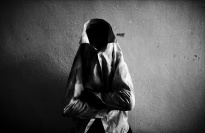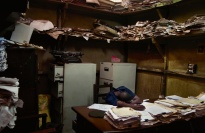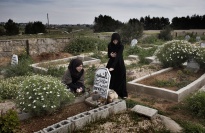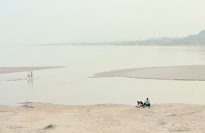About Moving Walls 20
On display at Open Society Foundations–New York from May to December 2013.
The Spring 2013 Moving Walls opening marks the 20th group exhibition organized by the Open Society Foundations. The exhibit comes as many of the regions where we work are in transition. This change and movement are reflected in Yuri Kozyrev’s documentation of uprisings in the Arab region and Ian Teh’s photographs showing the impact of China’s economic rise on the Yellow River. Katharina Hesse combines landscape with portraiture to document North Korean refugees seeking to cross the border into China. In contrast, Donald Weber’s photographs of police interrogations in Ukraine, and Fernando Moleres’s images of young men and boys in an adult prison in Sierra Leone, depict people whose movement is confined. The people in these pictures are in a state of limbo, as deeply flawed justice systems take over and determine their fate.
Moving Walls 20 also coincides with a move to a new headquarters in New York’s historic Argonaut building at 224 West 57th Street, under the leadership of our new president, Chris Stone. In honor of this occasion, Amy Yenkin, the director of the Documentary Photography Project, sat down with the exhibition curators Susan Meiselas and Stuart Alexander to reflect on the history of Moving Walls.
AMY YENKIN: In 1997, the Open Society Foundations were experiencing similar changes, when we moved into 400 West 59th Street. At the time, you were asked by Aryeh Neier, then the Foundations’ president, to advise him on what to do with the blank walls in our office. What was the context for the creation of Moving Walls?
SUSAN MEISELAS: When we started Moving Walls 16 years ago, the documentary photography community was struggling—pages of magazines were diminishing, and galleries were not interested in showing this kind of social documentary work. The question was: how do we support this community and articulate its work in a form other than a magazine or book? How do we continue to cultivate and engage a viewing public for documentary photography? I proposed Moving Walls as a rotating exhibit to address these concerns. The idea was to create an opportunity for documentary photographers to showcase their work in a physical environment where the exposure of issues they focused on would have presence and be valued.
At the same time, we conceived Moving Walls so people could come and understand what the Open Society Foundations stand for, what they care about.
AY: How has Moving Walls changed over time relative to the Foundations’ evolving mission and the shifting nature of documentary photography?
SM: The Open Society Foundations’ original mission was narrower, principally focused on Eastern Europe and the post–Soviet Union. As the Foundations have grown, the mission has opened up to different territories, both geographically and thematically, and has expanded the exhibition’s scope.
STUART ALEXANDER: Moving Walls has become not only an important way to recognize individual artists working on pressing issues, but also a place to gather and celebrate documentary photographers and the work they do. Moving Walls has become part of the whole continuum of support for contemporary photojournalism. When you look through the list of the many photographers we’ve featured since 1998, you see renowned photographers, some of whom were just 22 or 23 at the time and at the very beginning of their careers. Some went on to win major awards such as the W. Eugene Smith Grant or a Guggenheim Fellowship, and were accepted into prestigious photography collectives.
SM: I think, because of the Foundations’ values, Moving Walls has been a beacon for documentary work. Its support has been critical for documentary photographers to survive and continue believing in what they do. There are prizes that recognize documentary photography, but Moving Walls represents something very counter to prize culture.
AY: What are the unique aspects of curating a show for a venue like the Open Society Foundations?
SM: Unlike at a gallery or museum, the staff does not choose to see the work; they have to see it day after day for nine months. In the old space at 400 West 59th Street, we had a cafeteria to contend with, so we had practical concerns, such as “What can people eat around and live with?” On a more substantive level, the Open Society Foundations have specific thematic and geographical priorities. We decided to create a selection committee of program staff who were working on related issues. It’s always felt important to me that the curatorial process be a collaborative one.
SA: I think of Moving Walls as a collective reflection on the times. After the terrorist attacks on 9/11, the exhibition featured, among others, Abbas, Edward Grazda, and Amy Vitale, who were all dealing with issues surrounding Islam.
SM: Although Moving Walls is intended to reflect the Foundations’ mission and values, there have definitely been points in the exhibition’s history where we included work because we thought we should be showing it. Moving Walls addressed the war in Iraq with the work of Benjamin Lowy, Eugene Richards, Sean Hemmerle, and Nina Berman even though the Foundations weren’t doing any direct programming related to the conflict. As Americans, we felt involved and we felt a responsibility to do so.
AY: What role will Moving Walls play as the Open Society Foundations enter a new era?
SM: Moving Walls will remain a reflective space that’s transformative for people who give themselves the time to experience the work. What I like about the Open Society Foundations as an environment for viewing art is that you don’t go there intending to look at the work, like you would at a museum or a gallery. It’s a surprise encounter. This can create much more of a spark for engagement because it can disorient you. Moving Walls asks its audience to think about something unexpected.




